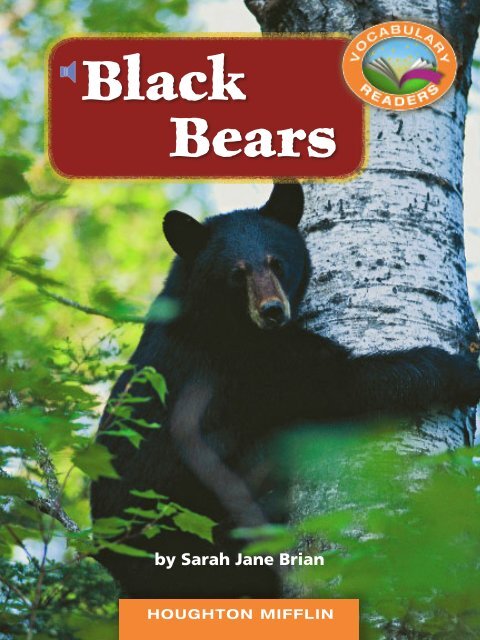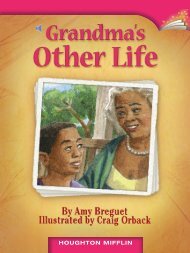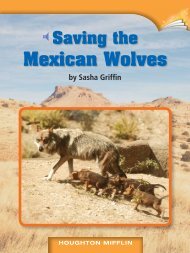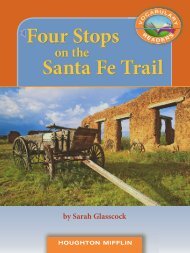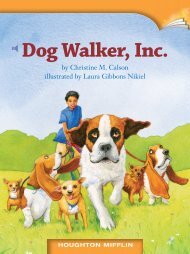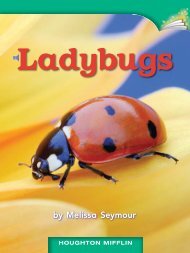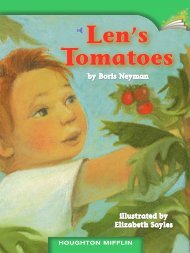Lesson 7:Black Bears
Lesson 7:Black Bears
Lesson 7:Black Bears
You also want an ePaper? Increase the reach of your titles
YUMPU automatically turns print PDFs into web optimized ePapers that Google loves.
<strong>Black</strong><br />
<strong>Bears</strong><br />
by Sarah Jane Brian<br />
HOUGHTON MIFFLIN
<strong>Black</strong> <strong>Bears</strong><br />
by Sarah Jane Brian<br />
PHOTOGRAPHY CREDITS: Cover Photodisc/Getty Images. Title page First Light/Getty Images. 2 Joel Sartore/Getty<br />
Images. 3 © DiMaggio/Kalish/CORBIS. 4 Altrendo/Getty Images. 6 © Daniel J. Cox/CORBIS. 7 © Tony Arruza/CORBIS.<br />
8 First Light/Getty Images. 10 Joel Sartore/Getty Images. 11 © Lowell Georgia/CORBIS. 12 Photodisc/Getty Images.<br />
13 © Lake County Museum/CORBIS. 14 Robert Caputo/Getty Images.<br />
Copyright © by Houghton Mifflin Harcourt Publishing Company<br />
All rights reserved. No part of this work may be reproduced or transmitted in any form or by any means, electronic or<br />
mechanical, including photocopying or recording, or by any information storage and retrieval system, without the prior<br />
written permission of the copyright owner unless such copying is expressly permitted by federal copyright law. Requests<br />
for permission to make copies of any part of the work should be addressed to Houghton Mifflin Harcourt School Publishers,<br />
Attn: Permissions, 6277 Sea Harbor Drive, Orlando, Florida 32887-6777.<br />
Printed in China<br />
ISBN-13: 978-0-547-02628-2<br />
ISBN-10: 0-547-02628-5<br />
1 2 3 4 5 6 7 8 0940 18 17 16 15 14 13 12 11<br />
If you have received these materials as examination copies free of charge, Houghton Mifflin Harcourt School Publishers<br />
retains title to the materials and they may not be resold. Resale of examination copies is strictly prohibited.<br />
Possession of this publication in print format does not entitle users to convert this publication, or any portion of it, into<br />
electronic format.
Bear on the Prowl<br />
The black bear felt hungry. He sniffed the<br />
morning air. Food smells were coming from a<br />
campsite at the edge of the forest. The bear<br />
began to stride toward the tempting smell.<br />
A locked cooler full of food sat on the ground.<br />
But the bear strained for only a moment to open it.<br />
One swipe with his massive paw, and the top<br />
popped right off. The bear began to eat.<br />
Suddenly, two hikers walked into their<br />
campsite. Lunging at them, the bear also let out<br />
a deep growl. The hikers wheeled around and<br />
ran away.<br />
<strong>Bears</strong> will eat berries, leaves, fish, honey, and other<br />
things they can find in the woods.<br />
2
<strong>Bears</strong> raid campsites for food.<br />
But then the scared hikers stopped running<br />
and froze. The bear stopped, too. The bear did not<br />
want to hurt the hikers. He just wanted to scare<br />
them away from his food. Then the bear went back<br />
to finish his meal.<br />
When a black bear runs towards a person and<br />
stops short, it is called a bluff charge. That means<br />
the bear does not want a fight. It wants to be left<br />
alone. But people often do not know this. They are<br />
picturing bears as a bigger danger than they really<br />
are. The result is a dangerous situation for both<br />
people and bears.<br />
3
Getting close to a bear in the wild makes most<br />
people frantic with fear. There are good reasons.<br />
<strong>Bears</strong> can easily hurt or kill a person. But black<br />
bear attacks are rare. In fact, most black bears are<br />
afraid of people. When they see a person, they<br />
usually run away.<br />
But sometimes bears do attack people.<br />
Usually attacks happen because people do not<br />
know how to behave in bear country. And<br />
frightened people sometimes kill bears. So it’s<br />
smart to learn more about these animals.<br />
<strong>Bears</strong> are attracted to food left at campsites.<br />
4
Getting to Know <strong>Black</strong> <strong>Bears</strong><br />
<strong>Black</strong> bears are the smallest bears in North<br />
America. They usually weigh about 150 to 500<br />
pounds. Grizzly bears and polar bears are much<br />
bigger. They can be as much as 1,500 pounds.<br />
Thousands of years ago, even larger animals<br />
lived on Earth. There were short-faced bears,<br />
saber-toothed cats, and others. <strong>Black</strong> bears were<br />
too small to fight these big animals.<br />
Many of these large animals lived on the<br />
grassy plains. So black bears stayed in the woods.<br />
Curved claws helped them climb trees to escape<br />
danger. <strong>Black</strong> bears learned to eat plant foods since<br />
larger animals took most of the prey. Because of<br />
this history, black bears are still shy today. They<br />
would rather run away from danger than fight.<br />
5
<strong>Black</strong> bears still live in forests. Cubs, or baby<br />
bears, romp on the forest floor while their mother<br />
looks for food. Cubs learn to climb trees very early.<br />
They are safe there among the branches.<br />
<strong>Black</strong> bears can be found from Canada<br />
to northern Mexico. They live in dozens of<br />
northern states.<br />
On the East Coast, most black bears are<br />
actually black. Farther west, some black bears<br />
are brown, cinnamon colored, white, or even<br />
bluish gray.<br />
<strong>Black</strong> bears with<br />
white fur are<br />
sometimes called<br />
spirit bears.<br />
6
Beekeepers use wire fences to keep bears away.<br />
<strong>Black</strong> bears have a good sense of smell. This<br />
helps them find food in the forest. Some favorites<br />
are nuts, berries, roots, and grasses.<br />
Another common food for black bears is insects.<br />
<strong>Bears</strong> often break open rotten logs to find the tasty<br />
grubs inside. When bears raid a beehive, they gobble<br />
down the honey. But bears also eat the bees.<br />
When they can get it, black bears eat meat and<br />
fish. <strong>Black</strong> bears will eat almost anything.<br />
7
In the fall, bears will walk for miles to find as<br />
much food as possible. At this time of year, a bear<br />
may eat 20,000 calories every day. That’s about as<br />
much as 42 hamburgers!<br />
All that food turns into a thick layer of fat.<br />
During the winter, the bear lives off the fat. The<br />
bear crawls into a den to sleep. In very cold places,<br />
the bear may stay in its den without eating or<br />
drinking for seven months.<br />
Most of a black bear’s food comes from plants.<br />
8
<strong>Bears</strong> and People<br />
<strong>Bears</strong> eat all kinds of food. Unfortunately,<br />
that includes the foods people eat. When bears<br />
get used to getting food from people, it means<br />
big trouble for the bears.<br />
People have hunted and killed bears for<br />
hundreds of years. Sometimes farmers kill bears<br />
that eat crops or kill farm animals. Other times,<br />
people hunt bears for sport or simply out of fear.<br />
Years ago, black bears were completely wiped<br />
out in many places.<br />
Today, more and more people have moved<br />
into bear country. People have built houses in<br />
the woods. Campers have shouldered backpacks<br />
full of food and hiked into the wilderness. <strong>Bears</strong><br />
quickly sniff out people’s garbage, pet food, and<br />
even birdfeeders. Once a bear sees people as a<br />
food source, it will return again and again.<br />
9
<strong>Bears</strong> search people’s rubbish for food.<br />
<strong>Bears</strong> that get food from people often lose their<br />
natural fear of humans. Instead of bounding away,<br />
they come looking for a meal. That is when a black<br />
bear becomes dangerous. It may break into cars,<br />
homes, or tents looking for food. Some bears start<br />
attacking people. Checking a bear’s violent<br />
behavior once it starts is very hard.<br />
<strong>Bears</strong> that attack people are often shot and<br />
killed. <strong>Bears</strong> that spend time near people also walk<br />
across roads. Cars occasionally hit them.<br />
10
It’s good to know what to do if you find<br />
yourself in bear country. How can you help keep<br />
black bears safe How can you keep yourself safe<br />
Here are some tips.<br />
• Leave them alone.<br />
• Don’t give them food.<br />
• Keep food and garbage in<br />
bear-proof containers.<br />
• Travel in groups.<br />
• Make noise to scare bears away.<br />
Today, park rangers teach families about bears<br />
before the families go camping in the woods.<br />
11
The Real Teddy Bear<br />
President Theodore “Teddy” Roosevelt<br />
loved the woods. He often went hunting. One<br />
day, Roosevelt saw a young black bear. Because<br />
the bear was so small, he refused to shoot it.<br />
Newspapers everywhere reported the story.<br />
Soon, a new toy was created. It was a little<br />
stuffed bear. It was named after the popular<br />
President. People loved the teddy bear and<br />
began to learn about real bears.<br />
12
Visitors go to Yellowstone National Park to see the bears.<br />
Don’t Feed the <strong>Bears</strong><br />
For many years, visitors to Yellowstone National<br />
Park loved to feed the black bears that lived there.<br />
Feeding the bears made a fun picture. <strong>Bears</strong> ate<br />
candy bars, chips, or whatever people fed them.<br />
But many people were hurt. <strong>Bears</strong> often bit or<br />
scratched. Some bears became violent “problem<br />
bears.” Hundreds of bears were either shipped to<br />
zoos or killed. Today, park bears are left alone to<br />
find their own natural foods.<br />
13
Good News<br />
The good news is that today black bears are<br />
doing well. Scientists say that there are 700,000<br />
or more black bears. Bear numbers are growing<br />
in many places.<br />
But people’s numbers are growing, too. We<br />
must protect land for black bears and learn how<br />
to live peacefully with them. These important<br />
animals need our help to stay safe.<br />
<strong>Black</strong> bears need lots of forestland to survive.<br />
14
Responding<br />
TARGET VOCABULARY Word Builder What<br />
other words could you use to describe a bear<br />
bounding through the woods Copy the word<br />
web and add more words.<br />
<br />
running<br />
bounding<br />
lunging<br />
<br />
Write About It<br />
Text to Text What makes a bear run away Write<br />
about another animal that you have read about<br />
that might run away for the same reason. Tell what<br />
happened. Use words from the web in your writing.<br />
15
TARGET VOCABULARY<br />
bounding<br />
checking<br />
frantic<br />
lunging<br />
picturing<br />
romp<br />
shouldered<br />
strained<br />
stride<br />
wheeled<br />
TARGET STRATEGY Visualize Use text details to form<br />
pictures in your mind of what you are reading.<br />
Drop the -ing and it’s what a waiter gives you<br />
at the end of your meal.<br />
16
Level: Q<br />
DRA: 40<br />
Science<br />
Strategy:<br />
Visualize<br />
Word Count: 1,272<br />
5.2.7 Build Vocabulary<br />
HOUGHTON MIFFLIN<br />
Online Leveled Books<br />
ISBN-13:978-0-547-02628-2<br />
ISBN-10:0-547-02628-5<br />
1032573


